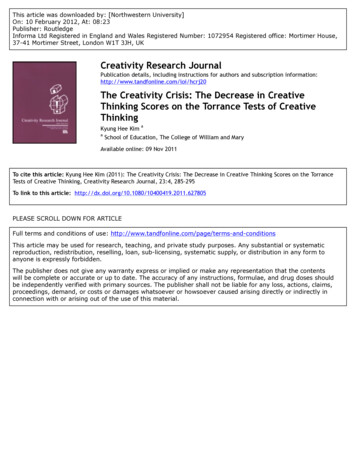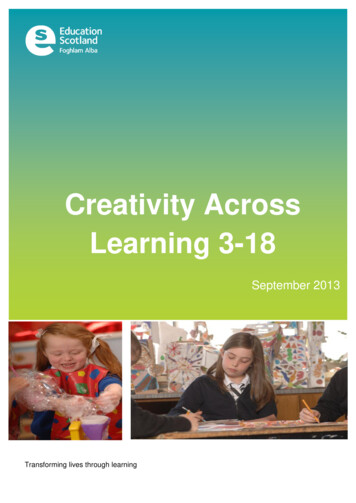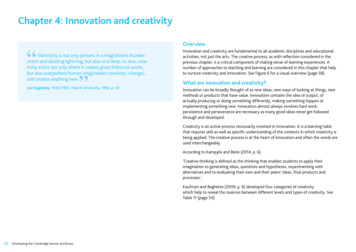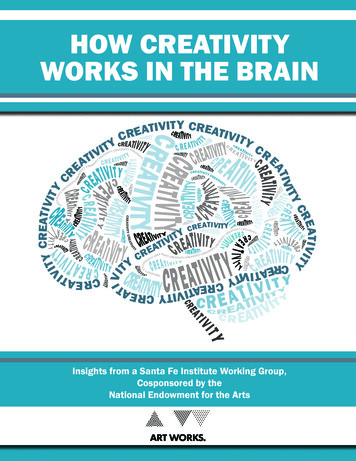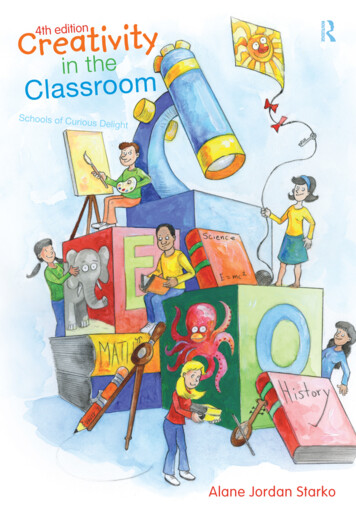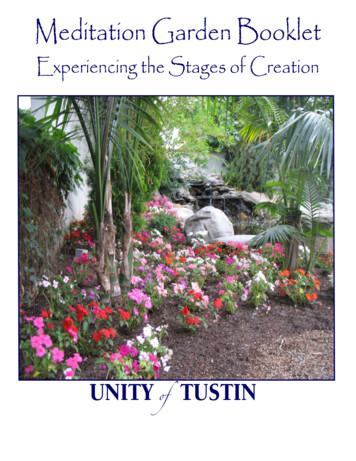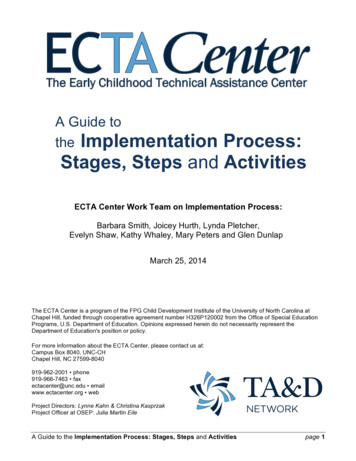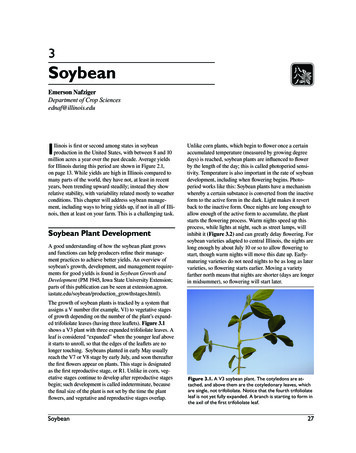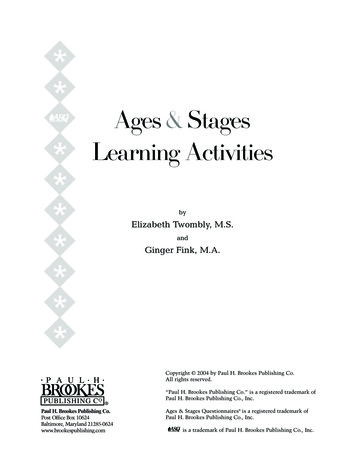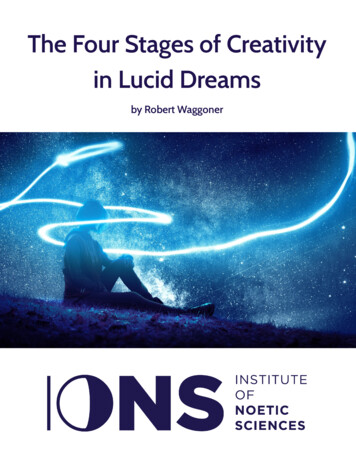
Transcription
The Four Stages of Creativityin Lucid Dreamsby Robert Waggoner
Table of ContentsIntroduction . 3First Stage of Lucid Dream Creativity: Unconscious Automatic Creativity . 5Second Stage of Lucid Dream Creativity: Conscious-Action Creativity . 7Third Stage of Lucid Dream Creativity: Accessing Your Larger Awareness . 8Fourth Stage of Lucid Dream Creativity: Creativity’s Essence . 11Questions. 11Resources . 12About the Author . 13Lucid Dreaming and Living Lucidly: Gateway to the Inner Self . 142 2020 Robert Waggoner; used by permission
IntroductionWhen you fire up a videogame and become immersed in the settings, activity and goals of the video reality(e.g., stopping zombies, exploring a new planet, fighting dinosaurs), your focus narrows to the actions,movements and resulting outcomes. Within the contextual setting of the video game, you help create thevibrant nature of this perceived reality.But as you play, a part of you knows, ‘Someone coded this programming.’As a lucid dreamer, have you ever asked yourself: ‘Who codes the lucid dream?’Behind the videogame scenes, someone helped structure the look, feel and potential actions. Someonepre-determined the mission, unexpected surprises and glorious goals. The breadth and depth of theperceived reality seem constrained by someone’s coding, design and programming.But who or what calls forth the images, situations, figures, actions and sometimes incredible knowledgewithin a lucid dream?Four years ago the Lucid Dreaming Experience magazine (which I co-edit at DreamingLucid.com) received alucid dream from Brian Aherne, which he says literally rocked him to his “foundations!” His edited luciddream report:“I had been watching nature programs on the TV and one of my questions was about theincredibly long annual migration of turtles to their traditional breeding grounds, a journey involving thousands upon thousands of miles. Why do they do it, was what I reallywanted to know; why do they travel so very far indeed just to breed?.Anyway [after performing WILD], the [lucid] dream began, and after adjusting myself tothe now fairly familiar surroundings of the dusty orange room, I quickly asked out loud:Why do turtles travel so very far in their migrations compared to other animals?For a few moments nothing happened, no response.3 2020 Robert Waggoner; used by permission
I prepared myself to ask the question again as sometimes it takes two or three times tobegin to get any answers, but before I could actually voice anything I suddenly foundmyself looking at what seemed to be an older map of the Earth comprised of a singlecontinent.And then, in open-mouthed amazement, I watched as it broke up into several continentsin a slow time lapse. Turtles, breeding only several hundred miles away originally,gradually being forced to travel farther and farther as these land masses gradually drift-ed apart over what must have been countless thousands of years. Until by now, thesepoor turtles are literally travelling several thousand miles each year just to reach theiroriginal breeding grounds! I was astounded to say the least!There were no words to this series of images, just the images themselves that appearedto be self-explanatory. And to this day I still don’t know if this revelation is actuallycorrect or not, but it certainly was a completely unexpected plus very startling result atthe time.”How do you explain what Brian saw in his lucid dream,after asking the question, “Why do turtles travel so veryfar in their migrations compared to other animals?”Did Brian tap into Carl Jung’s collective unconscious?Discover some level of inner knowledge? Or did heunknowingly craft a clever reply to his own question?This paper will explore the issue of ‘accessing creativity’in lucid dreams and how you can benefit from luciddreaming’s special access to deeper levels of innercreativity. Along the way, you will see why this shouldmatter for yourself, psychology and the world.4 2020 Robert Waggoner; used by permission
First Stage of Lucid Dream Creativity:Unconscious Automatic CreativityWhile giving a lucid dreaming workshop in Los Angeles last year, a participant asked me, “Can you explainhow to understand the differences between conscious, subconscious and unconscious?”I replied, “You seem consciously aware of asking a question of me right now. Simultaneously, you feelsubconsciously aware of your rear end sitting on the chair and the pressure there. Finally, you seemunconsciously aware of your fourth grade teacher.But now that I have drawn your attention to your fourth grade teacher, you feel consciously aware of thatpreviously unconscious information. As you can see, what was unconscious or subconscious can suddenlybecome ‘conscious’ by a shift in the focus of your awareness.”These three levels of conscious awareness exist within you simultaneously, but your focus largelydetermines which level you acknowledge or activate. For lucid dreamers this seems very important, asthey learn to lucidly observe the first stage of lucid dream creativity: Unconscious Automatic Creativity.Below, notice the lucid dream examples of Unconscious Automatic Creativity randomly selected fromsubmissions to the Lucid Dreaming Experience magazine (June 2018):“I was in my classroom at school when suddenly I did a reality check and became lucid. Ilooked around the room and noticed a pile of bread on the teacher’s desk When I gotoutside, I had to sit in amazement of how real and vivid everything was. I looked at myhands with full conscious awareness and they were indescribable. My fingers werebubbling and growing faces and arms and hands.” Matt J. (pg. 25)“[After landing on a beach, N. Rae becomes lucid] I walked out of the sand and onto acollege campus, across the quad and into the library. I was just having fun lookingaround me and at all the people, at the shelves of books, the dark green industrialcarpet. There were large windows and the sunlight filled the room.” N. Rae (pg. 27)5 2020 Robert Waggoner; used by permission
“Now convinced of having become lucid, I hurry down an alien staircase and enter a parkwith people milling around aimlessly.” Alexandra E. (pg. 17)As each lucid dreamer moves through dream-space, automatically and without conscious intent, newsettings and objects appear. Bread piles up on a teacher’s desk. A book-filled library with green carpet andlarge windows shows up. Emerging from the staircase, a park appears with people milling around.All of this creativity simply happens automatically and unconsciously. The lucid dreamer does not ‘control’it. Because it appears naturally and automatically, we rarely focus on this level of creativity.Who or what coded all of this creativity? Does this lucid dream creativity occur randomly, or does it seemguided by hidden principles?6 2020 Robert Waggoner; used by permission
Second Stage of Lucid Dream Creativity:Conscious-Action CreativityA lucid dreaming colleague, Joy Fatooh, shared a lucid dream in which she recalled a goal from the bookThe Tibetan Yogas of Dream and Sleep by Tenzin Wangyal Rinpoche. Becoming lucid, she saw a solitaryflower in a nearby vase. Determined to make more flowers appear, she tried to make it happen. Noneappeared. Feeling a bit frustrated, she began to jump up and down while mentally insisting a flowerappear. With each jump, another flower suddenly appeared created in the vase!The Buddhist dream yoga tradition encourages lucid dreamers to increase or decrease the number andquality of objects in a lucid dream to develop flexibility of mind, noting “As we are conditioned by theapparent solidity of thoughts, they should be dissolved by the limitless freedom of mind.” (pg. 126) Byusing the mind to create and de-create in a lucid dream, one sees how appearances change throughconnection to mental activity.Here, the lucid dreamer normally uses what I called the ‘Reality Creating Principles’ of Belief, Expectation,Focus, Intent/Will and X to create the perceived experience (see my first book, Lucid Dreaming – Gatewayto the Inner Self).Briefly stated, if you believe that you must swim through the air in a lucid dream (because you believephysical effort seems necessary for movement), then you will breast-stroke through dream space! But ifyou believe that gravity does not exist in the mental realm of lucid dreams, then your belief allows you tofly upside down or feet first! Your belief conditions and helps create your experience.Similarly, if you expect the dream figure in the dark coat to be dangerous, then he will turn and have a knifeto threaten you! However, if you switch your expectations and expect the dream figure in the dark coat tobe a priest, then he will turn and be wearing a clerical collar and carrying a holy book.If you become lucid and suddenly ‘focus’ on finding a desirable mate, then normally an attractive figure willemerge, who reflects your desire. Potentially however, you have the capacity to focus on most anythingwithin the freedom of lucid dreaming.7 2020 Robert Waggoner; used by permission
The energy of your beliefs, expectations, focus and intent/will help to ‘co-create’ your experience of dreamobjects, figures and situations. Seeing this, you begin to realize that you cannot understand the luciddream without understanding your own beliefs, expectations, focus and intent/will in that moment. Thelucid dream experiencer seem embedded in most every lucid dream experience, and helps co-create theperceived experience.But how can this explain Brian Aherne’s lucid experience of watching the single land mass break apart intocontinents as turtles continued to swim farther and farther to reach ancestral breeding grounds?To explain that, we need to introduce this:Third Stage of Lucid Dream Creativity:Accessing Your Larger AwarenessIn the third stage of creative action, the lucid dreamer asks a question within the lucid dream to a nonvisible aspect which then responds (e.g., the unconscious mind, one’s larger awareness, the inner self).For example, Brian asked, ”Why do turtles travel so very far in their migrations compared to otheranimals?” To be clear, he did not ask a random dream figure. Instead, he asked the non-visible awarenesswithin-the-dream and then observed an answer being created in response.In my first book, I explain my 1985 lucid dream realization that an ‘awareness behind the dream’ existedand would respond to requests or questions in a lucid dream. Stephen LaBerge also vaguely alluded to thisin his first book (published later in 1985), when he noted his lucid request “To seek the highest” led tosudden profound changes and some of his most incredible experiences. However LaBerge downplayed this,stating that who or what responds does not really matter at this point.With the 1993 release of Carlos Castaneda’s book, The Art of Dreaming, you see this same issue brought upagain. Castaneda, a UCLA anthropology grad student, asks his shamanic teacher Don Juan about the non visible voice that responds to questions in lucid dreams. Don Juan replies that he calls this voice, “thedreaming emissary” adding, “The emissary didn’t tell you anything new. Its statements were correct, but it8 2020 Robert Waggoner; used by permission
only seemed to be revealing things to you. What the emissary did was merely repeat what you alreadyknew.” In essence, one might say the dreaming emissary serves as the functional representative of yourknowledgeable inner self.For lucid dreamers who are new to this idea, I suggest that they begin with a simple request, such as“Dream, show me something important for me to see!” Normally, something will appear in the lucid dream(or, the entire lucid dream will change), which will be symbolically or literally ‘important’ for the person.However for those seeking access to creativity, the discovery of a new layer of creativity (as well as evidencefor another layer of self/Self awareness) seems truly profound!As you go deeper, you discover that you can lucidly explore concepts, ideas and information outside of theego’s knowing. I recall feeling stunned when I ignored the dream figures, looked up and asked in a luciddream, “Hey I want to hear my feeling tone!” (note: Jane Roberts book, The Nature of Personal Reality,stated everyone had a ‘feeling tone’ which constituted the essence of themselves in this life). Suddenly,high above me a small dark spot appears, and from it comes an “Aaahhh” sound. As I watch, it grows into aconical shape, vibrating this “AAaaHHhh” with greater intensity – until finally it vibrates ‘me’ out of existence! Years later, I learned that “ah” serves as the mantra sound connected to the Buddhist dream yogatradition.In an online workshop years ago, a chemistry and physics student, Marcelle, told me that she wished toexperience the reality of an electron in a lucid dream. I told Marcelle it seemed possible but only if Marcelle could let go of personal beliefs (which would tend to distort or limit the actual experience). On thefifth lucid dream attempt, Marcelle first asked the ‘awareness’ to take her to the sub-atomic level; oncethere, she asked to experience the reality of an electron – with extraordinary results!For those who believe that the lucid dream simply ‘makes up’ a plausible response, numerous examplesexist of this unseen awareness telling the lucid dreamer that “You do not seem prepared for an experienceof this type ” or the lucid dreamer’s request is based on an errant assumption, whereupon the awarenessgives a corrected analysis.9 2020 Robert Waggoner; used by permission
So What?To this point, you can see how lucid dreaming reflects ‘creativity’ in the stages:1) The Automatic Unconscious level which creates new scenes, figures and activity,2) The Conscious-Action Creativity in which the lucid dreamer uses their belief, expectation, focus, intent/will to create objects, figure and situations,3) And then the stage of Accessing Your Larger Awareness – reaching out to your conscious-unconsciousmind or inner self and seeing its enormously profound and unexpected response.At each level, you see a new facet of creativity’s expression along with the movement into deeper layers ofthe self’s knowing:1) Unconscious, 2) Ego/conscious self, and then 3) Aware inner self.When you realize the enormous problems andchallenges facing the world, accessing the third stageopens up the use of lucid dreaming to explore solutions,concepts, inventions and ideas which could profoundlyand constructively touch society and the planet!Moreover, a recognition by psychology of the thirdstage (accessing an inner awareness) would serve toexpand the conceptual view of the self -- away from theextremely limited and materialistic view of an ego/conscious self -- and towards the expansive view of anaccessible and aware inner Self!This explains why lucid dreaming matters – it allowsaccess to normally unconscious creativity – and it showsthe actual nature of an aware inner Self.10 2020 Robert Waggoner; used by permission
Fourth Stage of Lucid Dream Creativity:Creativity’s EssenceIn the final stage of creativity, the lucid dreamer seeks out the ‘source’ of this inner awareness’s knowingand creativity. One might call this becoming a type of ‘source-erer’ – or following creativity all the way tothe Creator.In what realm does the source of creativity exist? Does a realm exist free of the projected influence ofbelief, expectation, focus, intent/will and one’s mindset?Normally these deeper lucid encounters with the essence of creativity involve light, sound, geometry and/or energy. Some show elements of a loss of ego/conscious self-identity and a more expansive and selflessawareness. As I sought out this realm, I would fall asleep and the entire night was ‘blue light’ – no me, noaction, no symbols – just blue light. In my first book, I explain how this eventually led to the goal of dreamyoga as explained by Tenzin Wangyal Rinpoche, “An experience of the clear light of awareness by aware-ness itself.Through experience, lucid dreaming can show you distinct layers of creativity, couched in layers of the self.Accessing that creativity may be mankind’s greatest hope to face epic challenges.QuestionsHave you noticed these stages of creativity in your own lucid dream experience?Where does the creativity come from? Does it seem random or purposeful?Have you ever ignored the dream figures and asked a question of the unconscious mind or awareness behind the dream? What happened?Could you see how accessing creativity through lucid dream could help bring new inventions and ideas intothe waking world?Who codes the lucid dream?I look forward to hearing your experiences and discussing this more deeply with you!11 2020 Robert Waggoner; used by permission
ResourcesBrian Aherne, Knowledge from Dreams: Accessing the Subconscious Mind, Lucid Dreaming Experience, Vol.5, No. 2, 3.pdfJoy Fatooh, DreamSpeak interview, The Lucid Dream Exchange, March ads/2015/06/LDE-46-Spring-March-2008.pdfAssorted lucid dream excerpts, Lucid Dreaming Experience, June, ds/2018/06/2018-JUNE-LDE-Web-Version.pdfTenzin Wangyal Rinpoche, The Tibetan Yogas of Dream and Sleep (Ithaca, New York: Snow LionPublications, 1998),Robert Waggoner, Lucid dreaming: Gateway to the Inner Self (Needham, MA: Moment Point Press, 2009)Marcelle Liemant, Using Lucid Dreaming to Experience the Subatomic Level, Lucid Dreaming Experience,Spring 2015, 015/05/2015-vol-3-no4-Spring.pdfCarlos Castaneda, The Art of Dreaming (New York: Harper Collins, 1993), p. 65.Jane Roberts, The Nature of Personal Reality, (Englewood Cliffs, NJ: Prentice-Hall, 1974)12 2020 Robert Waggoner; used by permission
About the AuthorRobert Waggoner wrote the acclaimed book, Lucid Dreaming – Gateway to the Inner Self (now in its tenthprinting), and co-authored Lucid Dreaming Plain and Simple with Caroline McCready. Both books are inAudible, Kindle and CD/Mp3. His books have been translated into French, German, Chinese, Korean, Czech,Finnish and other languages.A past President of the International Association for the Studyof Dreams (IASD), Waggoner serves at co-editor of the onlinemagazine, The Lucid Dreaming Experience, (ISSN 2167-616X);the only ongoing publication devoted specifically to luciddreaming. A lucid dreamer since 1975, he has logged morethan 1,000 lucid dreams.lucidadvice.com RobertLucidDreaming@gmail.com13 2020 Robert Waggoner; used by permission
Lucid Dreaming and Living Lucidly:Gateway to the Inner SelfA four-week online workshop with support and guidance provided byRobert Waggoner, Gillian Thetford, and Ed KelloggWinter Cohort Starts February 17, 2021This workshop speaks to all explorers of lucid dreaming – from the inexperienced beginner to those whohave ventured far along the path. While giving you sound foundational materials, it offers insight far beyond lucid dreaming basics. This workshop is for the lucid dream explorer, the adventurers and the curious,who seeks to understand this fascinating state of being and to access a larger awareness of the consciousness for growth, insight and transformation. Learn more and register at:noetic.org/lucid-dreamingnoetic.org info@noetic.org101 San Antonio Road Petaluma, CA 94952707-775-350014 2020 Robert Waggoner; used by permission
A lucid dreaming colleague, Joy Fatooh, shared a lucid dream in which she recalled a goal from the book The Tibetan Yogas of Dream and Sleep by Tenzin Wangyal Rinpoche. ecoming lucid, she saw a solitary flower in a nearby vase. Determined to ma

